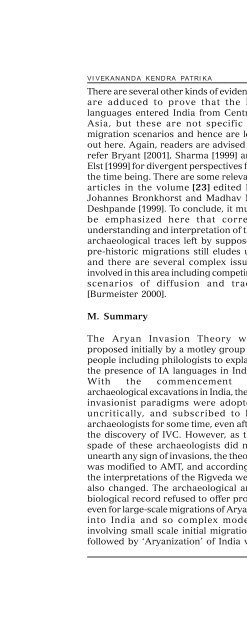Aryan Invasion Theory - Publication - Vivekananda Kendra
Aryan Invasion Theory - Publication - Vivekananda Kendra
Aryan Invasion Theory - Publication - Vivekananda Kendra
You also want an ePaper? Increase the reach of your titles
YUMPU automatically turns print PDFs into web optimized ePapers that Google loves.
VIVEKANANDA KENDRA PATRIKA<br />
There are several other kinds of evidence<br />
are adduced to prove that the IA<br />
languages entered India from Central<br />
Asia, but these are not specific to<br />
migration scenarios and hence are left<br />
out here. Again, readers are advised to<br />
refer Bryant [2001], Sharma [1999] and<br />
Elst [1999] for divergent perspectives for<br />
the time being. There are some relevant<br />
articles in the volume [23] edited by<br />
Johannes Bronkhorst and Madhav M.<br />
Deshpande [1999]. To conclude, it must<br />
be emphasized here that correct<br />
understanding and interpretation of the<br />
archaeological traces left by supposed<br />
pre-historic migrations still eludes us,<br />
and there are several complex issues<br />
involved in this area including competing<br />
scenarios of diffusion and trade<br />
[Burmeister 2000].<br />
M. Summary<br />
The <strong>Aryan</strong> <strong>Invasion</strong> <strong>Theory</strong> was<br />
proposed initially by a motley group of<br />
people including philologists to explain<br />
the presence of IA languages in India.<br />
With the commencement of<br />
archaeological excavations in India, these<br />
invasionist paradigms were adopted<br />
uncritically, and subscribed to by<br />
archaeologists for some time, even after<br />
the discovery of IVC. However, as the<br />
spade of these archaeologists did not<br />
unearth any sign of invasions, the theory<br />
was modified to AMT, and accordingly<br />
the interpretations of the Rigveda were<br />
also changed. The archaeological and<br />
biological record refused to offer proof<br />
even for large-scale migrations of <strong>Aryan</strong>s<br />
into India and so complex models<br />
involving small scale initial migrations<br />
followed by ‘<strong>Aryan</strong>ization’ of India via<br />
117<br />
ARYAN INVASION THEORY<br />
acculturation are now used. Language<br />
transfer via Elite Dominance (over IVC<br />
inhabitants) of IA speaking ‘migrants’ on<br />
horse driven chariots often plays a<br />
significant role in these ‘complex’<br />
scenarios. Nevertheless, all these models<br />
remain just models with no conclusive<br />
evidence supporting them – despite<br />
claims to the contrary. The prior<br />
acceptance of these models is often used<br />
to ‘explain’ several features of the Indian<br />
civilization. In other words, assumptions<br />
are often taken as ‘results’ of these<br />
models.<br />
Part III: Notes and References<br />
Notes<br />
[1] There is also a minority view that IA (or other IE)<br />
languages entered India much earlier. For instance,<br />
Renfrew suggests that IE languages could have left<br />
Anatolia towards India around 6000 BCE [Renfrew<br />
1987:189-197, 206]. Renfrew’s views have come in for<br />
sharp criticism because they are opposed to the<br />
standard paradigms of the Indo-European studies.<br />
Jose Carlos Calazans, a Portuguese scholar also opines<br />
that the PIE homeland was in Central Asia, whence<br />
the IA languages entered India around 3000 BCE.<br />
See Koenraad Elst’s message on the Indology List<br />
dated 14 July 2000, available at URLhttp://<br />
l i s t s e r v . l i v . a c . u k / c g i - s h l /<br />
WA.EXE?A2=ind0007&L=indology&P=R16562<br />
In such scenarios, IVC is considered a Sanskritic<br />
culture, or at least a culture wherein IA speakers<br />
formed a dominant membership of its milieu.<br />
Calazans’ work on the decipherment of the IVC script<br />
is said to be under publication by the Oxford<br />
University Press, per the information provided by<br />
Koenraad Elst (on 7 February 2000) in an article at the<br />
URL http://pws.the-ecorp.com/Chbrughmans/<br />
articles/Indusscr.html<br />
Diametrically opposed to the view of the intrusion of<br />
IE or IA languages into India from Central Asia, is<br />
the view that the PIE homeland was in India. I propose<br />
to deal with the different varieties of this view<br />
elsewhere.

















